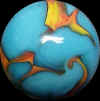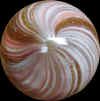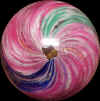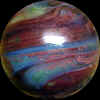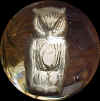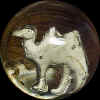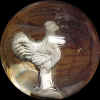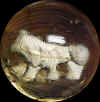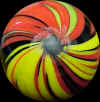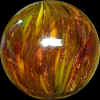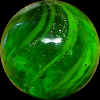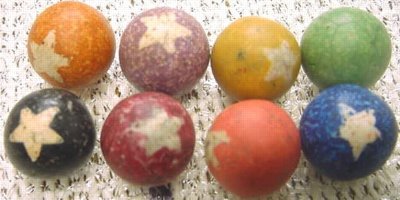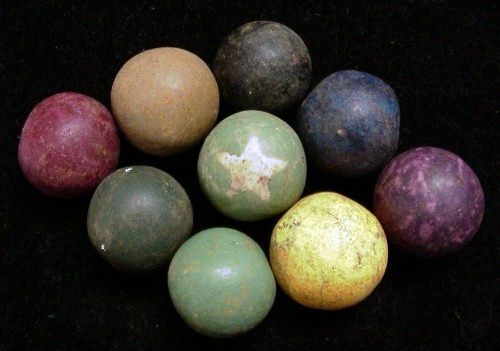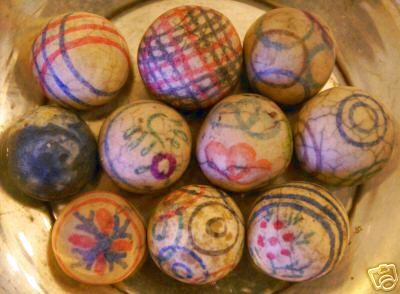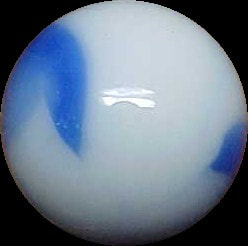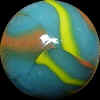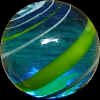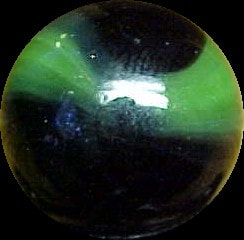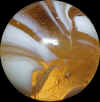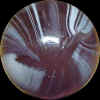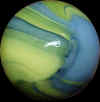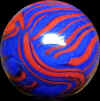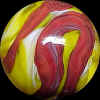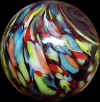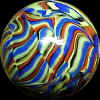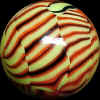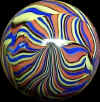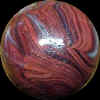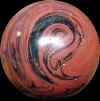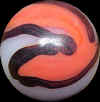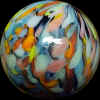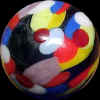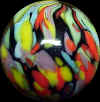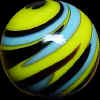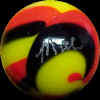FAKES & REPRODUCTIONS
Wherever there is a collectibles market, there will be reproductions. The hobby of marble collecting is certainly no exception and as the popularity of the hobby soars, so does the number of people trying to make money from producing and/or selling reproductions. This page will discuss the following topics:
- Repaired Marbles
- Reproduction Hand Made Marbles
- Reproduction Machine Made Marbles
POLISHED, BUFFED, REMELTS & FILLED MARBLES
Marbles that have been repaired through any of a number of methods are not reproductions a warning about them is appropriate here because they, like fakes and reproductions, are often passed off on to unsuspecting and/or inexperienced collectors. While sometimes polishing is the only choice available to make an old marble viewable, these methods will reduce the value of a marble by 50-75%.
German handmade marbles are the most often repaired. Many types have a clear layer of glass between the design that can be ground down while still keeping the integrity of the design. The most commonly polished are sulphide marbles.
Polishing and buffing are the two most common methods of repairing damaged marbles. This is usually done to rare marbles that have too much damage (flakes, chips, wear, etc.) to be enjoyed on display. Both methods involve grinding away the surface of the marble; polishing removes a good deal of glass while buffing is more superficial. The method used depends on the depth of the damage present. Polishing is more common on handmade marbles and buffing seems to be done more to machine made marbles. On the former type, the polishing usually removes the pontils though sometimes artificial ones are added. The best method to detect polishing and buffing is to closely examine the marble under magnification. Often, all of the damage is not removed and tiny scars, often crescent shaped, will remain.
These scars, along with pits and flakes that may be left behind, will have smoothed edges. Polishing and buffing is not practical for some types of marbles, especially those hand made types that have bands of color on the surface (Indians, Banded Transparents, Clambroths, etc.), while on some machine made marbles the removal of glass from the surface can alter the design or even certain colors. This is most evident on such examples as National Line Rainbos.
Some marbles, particularly larger hand made examples, have deep pits and chips that have been filled with a clear polymer to fill in and disguise the damage. These often go unnoticed by the untrained eye. However, such alteration is fairly easy to detect. First, depending on the size of the filled area, the surface of the repaired area will have a different appearance than the rest of the marble. Often it is uneven or has a dull look as compared to the rest of the marble, or may even have an "orange peel" texture. Most polymers will show up under ultraviolet light, so if a marble that has filled areas is held under a black light, often these areas will glow a bit more than the rest of the marble and the repaired areas really stand out. A final method to detect filling is to prick the marble all over with a pin or needle. The sharp end of the object will sink into any filled spots while the areas of glass will not yield.
"Remelts" are perhaps the most difficult method of repairing marbles and therefore is not often done, as few have the skills to do this. Such repaired marbles are also the toughest to identify. Remelts actually involve heating the damaged marble to a high enough temperature so that the glass becomes partially molten, allowing such damage as fractures and cracks to "heal." When done on German handmade marbles, it usually results in lots of bubbles left in the clear glass. Sometimes the marble is completely altered from its original appearance; such is especially true for expensive oxblood marbles like Leightons. At other times, the original design must not be altered, so the amount of cooking is less severe.
REPAIRED MARBLES GALLERY
(Hover your mouse or lightly touch the image to see the type of marble. Click to view the full size image)
(Hover your mouse or lightly touch the image to see the type of marble. Click to view the full size image)
REPRODUCTION HAND MADE SWIRLS
Today there are scores of glass artists who are creating hand made marbles. Mostly, these do not imitate the classic designs and styles of antique hand made marbles, though many draw inspiration from them. However, a few artists are very skilled at creating marbles that are virtually identical to genuine old marbles. Unlike many other types of contemporary marbles, many of these are left unsigned and even have pontils. Though few makers of such marbles actually try to pass them off as old, the marbles do often get eventually sold to those without such scruples.
It is very difficult for the inexperienced collector to be able to tell reproduced hand made marbles from their genuine counterparts. However, a few cautionary notes can help you from being fooled. If the marble is absolutely pristine, with no damage and not even a sign of normal aging of glass (haze, patination, wear, frosting, etc.), chances are it could be a fake. If it is being offered at a price that is far lower than you believe it should go for, stop a moment and think before buying it----why is the person selling such a marble for a cost far below "book value"?
CALIFORNIA SULPHIDES
Between late 1993 and early 1994, several Sulphides with never-before-seen figurines appeared on the market. One group originated from California and another group came from Florida; collectively, these have become known as the "California Sulphides." The California examples were said to have been found in East Germany when the Berlin Wall was brought down, while the Florida examples were said to have been unearthed from the site of a drugstore that had been owned by a German immigrant. Besides containing previously unknown figurines, many of these Sulphides had double figurines. Prior to this only around a dozen were known.
I have spoken with several well known collectors on this subject and my own conclusion is that the marble collecting community is about equally split between calling the so-called California Sulphides fake and genuine. Since the marble collecting community is divided on this issue, it is up to you to decide for yourself whether they are fakes or not.
REPAIRED SULPHIDES
Sulphides are again becoming the target of misrepresentation following a hiatus after the "California Sulphide" controversy. Since Sulphides are difficult to find, and very expensive, in mint condition, damaged ones are being repaired with polishing and/or polymers to fill in deep chips. Some are also being coated with green glass not only to repair them but to give them the appearance of far more valuable colored glass sulphides. Though often sold as repaired and altered, others who buy them as such may not be so honest in their descriptions and might try to pass them off as genuine. Known examples include amber coating (monkey and coin), green coating (eagle, dog, and turtle), cobalt (numeral and cow), and blue (lion).
REPRODUCED & NEW SULPHIDES
Sulphides are also being reproduced. As the contemporary "art glass" marble market continues to expand, artists are not only exploring new design techniques but are creating "classic" pieces. Thomas Thornburgh is one such artist who creates sulphides that are not meant to be exact reproductions of older examples but employ new figurines. Thornburgh's sulphides lack pontils, and there is also some darker swirling in the glass, a trait not seen on original pieces. Jim Davis of Pennsboro, West Virginia and Ray Laubs are a few of several artists creating sulphides. Some have painted figurines and would not easily be mistaken for old. Again, it needs to be noted that most of the individual artists are not making these to precisely copy the old styles and certainly are not trying to pass them off as old. Yet, as they are bought up by others, beware of them being attempted to be passed off as antique. However, some sulphides coming out of Germany in the last 10 years seem to be intentional copies.
Today there are scores of glass artists who are creating hand made marbles. Mostly, these do not imitate the classic designs and styles of antique hand made marbles, though many draw inspiration from them. However, a few artists are very skilled at creating marbles that are virtually identical to genuine old marbles. Unlike many other types of contemporary marbles, many of these are left unsigned and even have pontils. Though few makers of such marbles actually try to pass them off as old, the marbles do often get eventually sold to those without such scruples.
It is very difficult for the inexperienced collector to be able to tell reproduced hand made marbles from their genuine counterparts. However, a few cautionary notes can help you from being fooled. If the marble is absolutely pristine, with no damage and not even a sign of normal aging of glass (haze, patination, wear, frosting, etc.), chances are it could be a fake. If it is being offered at a price that is far lower than you believe it should go for, stop a moment and think before buying it----why is the person selling such a marble for a cost far below "book value"?
CALIFORNIA SULPHIDES
Between late 1993 and early 1994, several Sulphides with never-before-seen figurines appeared on the market. One group originated from California and another group came from Florida; collectively, these have become known as the "California Sulphides." The California examples were said to have been found in East Germany when the Berlin Wall was brought down, while the Florida examples were said to have been unearthed from the site of a drugstore that had been owned by a German immigrant. Besides containing previously unknown figurines, many of these Sulphides had double figurines. Prior to this only around a dozen were known.
I have spoken with several well known collectors on this subject and my own conclusion is that the marble collecting community is about equally split between calling the so-called California Sulphides fake and genuine. Since the marble collecting community is divided on this issue, it is up to you to decide for yourself whether they are fakes or not.
REPAIRED SULPHIDES
Sulphides are again becoming the target of misrepresentation following a hiatus after the "California Sulphide" controversy. Since Sulphides are difficult to find, and very expensive, in mint condition, damaged ones are being repaired with polishing and/or polymers to fill in deep chips. Some are also being coated with green glass not only to repair them but to give them the appearance of far more valuable colored glass sulphides. Though often sold as repaired and altered, others who buy them as such may not be so honest in their descriptions and might try to pass them off as genuine. Known examples include amber coating (monkey and coin), green coating (eagle, dog, and turtle), cobalt (numeral and cow), and blue (lion).
REPRODUCED & NEW SULPHIDES
Sulphides are also being reproduced. As the contemporary "art glass" marble market continues to expand, artists are not only exploring new design techniques but are creating "classic" pieces. Thomas Thornburgh is one such artist who creates sulphides that are not meant to be exact reproductions of older examples but employ new figurines. Thornburgh's sulphides lack pontils, and there is also some darker swirling in the glass, a trait not seen on original pieces. Jim Davis of Pennsboro, West Virginia and Ray Laubs are a few of several artists creating sulphides. Some have painted figurines and would not easily be mistaken for old. Again, it needs to be noted that most of the individual artists are not making these to precisely copy the old styles and certainly are not trying to pass them off as old. Yet, as they are bought up by others, beware of them being attempted to be passed off as antique. However, some sulphides coming out of Germany in the last 10 years seem to be intentional copies.
REPAIRED, REPRODUCED & FAKE HAND MADE SWIRLS & SULPHIDES GALLERY
(Hover your mouse or lightly touch the image to see the type of marble. Click to view the full size image)
(Hover your mouse or lightly touch the image to see the type of marble. Click to view the full size image)
ATLANTA PORCELAIN & CIVIL WAR MARBLES
The picture below may seem familiar to you, especially if you live or travel in the southeastern United States. They are the "marbles" that were allegedly dug in 1991 during renovation in Atlanta, Georgia, in preparation for the then-upcoming Summer Olympics. Apparently, a construction worker unearthed 50,000 of these and somehow the story got to the newspaper that they represented porcelain marbles produced by a local factory during the 1820s-1830s. Since the time of recovery these "marbles" have found their way into many antique and collectible venues, particularly in such states as Georgia and Florida.
Are they genuine? The fact is this: during the period in question Atlanta was a small village, incapable of supporting a marble factory, much less one manufacturing porcelain specimens during an era when most children's marbles were made of limestone and imported from Germany. In fact, there was never a marble factory in America until the late 1800s, and most of these made softer-paste earthenware marbles as a sideline while concentrating on other forms of ceramics. Also, when found these marbles were unpainted; the colors you see were added subsequent to their excavation. The paint has been shown to most likely be latex, a type of paint not available then. In fact, these are probably spheres that were used in mill drums. It needs to be noted that to my knowledge they never appeared in any collections prior to 1991 and they have never been encountered during archaeological investigations.
These "marbles," being comprised of industrial porcelain (introduced to America sometime after 1860), are heavy to the touch and measure 3/4" or slightly smaller and sometimes up to 13/16". When painted, they will often be brown, red, green, blue, purple, or beige. Some have designs on them, most likely a single star that exposes the natural color of the underlying porcelain. I surmise that these were made by placing on the sphere one of those stick-on stars teachers like to put on highly graded exams, dipping it in paint, then removing the star following drying of the paint. Others I have seen have even been brashly decorated with a magic marker, often in geometric patterns.
Almost a decade after their "discovery," these objects remain the subject of some controversy and the latest tall tales have them being excavated from Civil War battlefield sites, to make them appealing to collectors of militaria.
The picture below may seem familiar to you, especially if you live or travel in the southeastern United States. They are the "marbles" that were allegedly dug in 1991 during renovation in Atlanta, Georgia, in preparation for the then-upcoming Summer Olympics. Apparently, a construction worker unearthed 50,000 of these and somehow the story got to the newspaper that they represented porcelain marbles produced by a local factory during the 1820s-1830s. Since the time of recovery these "marbles" have found their way into many antique and collectible venues, particularly in such states as Georgia and Florida.
Are they genuine? The fact is this: during the period in question Atlanta was a small village, incapable of supporting a marble factory, much less one manufacturing porcelain specimens during an era when most children's marbles were made of limestone and imported from Germany. In fact, there was never a marble factory in America until the late 1800s, and most of these made softer-paste earthenware marbles as a sideline while concentrating on other forms of ceramics. Also, when found these marbles were unpainted; the colors you see were added subsequent to their excavation. The paint has been shown to most likely be latex, a type of paint not available then. In fact, these are probably spheres that were used in mill drums. It needs to be noted that to my knowledge they never appeared in any collections prior to 1991 and they have never been encountered during archaeological investigations.
These "marbles," being comprised of industrial porcelain (introduced to America sometime after 1860), are heavy to the touch and measure 3/4" or slightly smaller and sometimes up to 13/16". When painted, they will often be brown, red, green, blue, purple, or beige. Some have designs on them, most likely a single star that exposes the natural color of the underlying porcelain. I surmise that these were made by placing on the sphere one of those stick-on stars teachers like to put on highly graded exams, dipping it in paint, then removing the star following drying of the paint. Others I have seen have even been brashly decorated with a magic marker, often in geometric patterns.
Almost a decade after their "discovery," these objects remain the subject of some controversy and the latest tall tales have them being excavated from Civil War battlefield sites, to make them appealing to collectors of militaria.
ATLANTA PORCELAIN & CIVIL WAR MARBLES GALLERY
(Hover your mouse or lightly touch the image to see the type of marble. Click to view the full size image)
(Hover your mouse or lightly touch the image to see the type of marble. Click to view the full size image)
MODERN MARBLE KING MARBLES
The recent Marble King Rainbows may be differentiated from the originals because they have the same colors on both poles and a central ribbon of the second color. The originals have a patch on one pole consisting of one color, followed by a ribbon of a second color around the equator, a ribbon of the first color around the equator, and finally a patch of the second color on the opposite pole.
VACOR DE MEXICO
Other marble companies besides Marble King are producing marbles that look superficially like older marbles. The Mexican manufacturer, Vacor de Mexico, is currently offering marbles that could easily fool less experienced collectors. One looks a lot like the Peltier Superman (Serpent) and has the same colors. These new versions can be distinguished from the old because they have a swirling pattern differing from the original and lack the seams and separate ribbons of color that you will find on genuine Peltiers. Other types like Twister, Rooster and Zulu look a lot like red, yellow, and black Christensen Agate swirls. Again, there are subtle differences in the colors between the old and the new. Also, the new examples have an obvious "orange peel" texture which is more evident on the larger sizes. Your best defense against these is to compare and contrast them side by side, and be wary of "valuable" marbles being sold at a price far less that they should. If it sounds too good to be true, chances are it is.
MODERN HANDMADE CHINESE MARBLES
Many of the new styles of Chinese marbles are going to be passed off as older machine made marbles. Why? Because there are a few styles that mimic, probably unintentionally, older marble designs. One looks like a Christensen Guinea and has a transparent amber, clear, transparent green, translucent yellow, and transparent blue base. These could be mistaken for genuine Christensens by inexperienced collectors. Among other distinguishing traits, these lack seams, which are always on original Guineas.
There is also a corkscrew variety available in several combinations, always with a clear base: light blue and white on clear, yellow and white on blue, white and blue on green, pale green on clear, blue on clear, white and orange on clear, yellow on clear, and red and white on clear. These should be easily recognizable, not only because of the pontils on either pole (one melted and one "nub"), but because the spirals are very thin. A final type is similar to the corkscrew but is formed like an auger inside the marble. These are even less similar to genuine Akro Agates than the corkscrews mentioned above.
GERMAN STRIPED TRANSPARENT & OPAQUES
Germany produced a machine made marble that looks remarkably similar to some Christensen Striped Transparents and Opaques. These manufactured in the 1950s 60S. These marbles may have a transparent base, in colors of blue, clear, peach, green, purple, yellow, and red, in approximate order of increasing rarity, or less commonly they may have an opaque base. Rarely, these may have multicolored stripes (especially on the opaque examples), but the transparent ones almost always have white.
These marbles always have two seams which actually crimp into the marble, much like Master Marble seams. Though there are slight variations, these seams are typically set opposite one another and are shaped like wide "U"s. The direction of the "U" is opposite that of the one opposite it. This, too, is quite similar to Master seams. These seams are the real trait that will differentiate them from Christensen Agate Striped Transparents (and Opaques). Those intimately acquainted with the marbles of both companies will notice subtler differences, too. It is particularly important to be cautious with the peach colored examples, as they are often also mistaken for rare Christensen peach slags.
The recent Marble King Rainbows may be differentiated from the originals because they have the same colors on both poles and a central ribbon of the second color. The originals have a patch on one pole consisting of one color, followed by a ribbon of a second color around the equator, a ribbon of the first color around the equator, and finally a patch of the second color on the opposite pole.
VACOR DE MEXICO
Other marble companies besides Marble King are producing marbles that look superficially like older marbles. The Mexican manufacturer, Vacor de Mexico, is currently offering marbles that could easily fool less experienced collectors. One looks a lot like the Peltier Superman (Serpent) and has the same colors. These new versions can be distinguished from the old because they have a swirling pattern differing from the original and lack the seams and separate ribbons of color that you will find on genuine Peltiers. Other types like Twister, Rooster and Zulu look a lot like red, yellow, and black Christensen Agate swirls. Again, there are subtle differences in the colors between the old and the new. Also, the new examples have an obvious "orange peel" texture which is more evident on the larger sizes. Your best defense against these is to compare and contrast them side by side, and be wary of "valuable" marbles being sold at a price far less that they should. If it sounds too good to be true, chances are it is.
MODERN HANDMADE CHINESE MARBLES
Many of the new styles of Chinese marbles are going to be passed off as older machine made marbles. Why? Because there are a few styles that mimic, probably unintentionally, older marble designs. One looks like a Christensen Guinea and has a transparent amber, clear, transparent green, translucent yellow, and transparent blue base. These could be mistaken for genuine Christensens by inexperienced collectors. Among other distinguishing traits, these lack seams, which are always on original Guineas.
There is also a corkscrew variety available in several combinations, always with a clear base: light blue and white on clear, yellow and white on blue, white and blue on green, pale green on clear, blue on clear, white and orange on clear, yellow on clear, and red and white on clear. These should be easily recognizable, not only because of the pontils on either pole (one melted and one "nub"), but because the spirals are very thin. A final type is similar to the corkscrew but is formed like an auger inside the marble. These are even less similar to genuine Akro Agates than the corkscrews mentioned above.
GERMAN STRIPED TRANSPARENT & OPAQUES
Germany produced a machine made marble that looks remarkably similar to some Christensen Striped Transparents and Opaques. These manufactured in the 1950s 60S. These marbles may have a transparent base, in colors of blue, clear, peach, green, purple, yellow, and red, in approximate order of increasing rarity, or less commonly they may have an opaque base. Rarely, these may have multicolored stripes (especially on the opaque examples), but the transparent ones almost always have white.
These marbles always have two seams which actually crimp into the marble, much like Master Marble seams. Though there are slight variations, these seams are typically set opposite one another and are shaped like wide "U"s. The direction of the "U" is opposite that of the one opposite it. This, too, is quite similar to Master seams. These seams are the real trait that will differentiate them from Christensen Agate Striped Transparents (and Opaques). Those intimately acquainted with the marbles of both companies will notice subtler differences, too. It is particularly important to be cautious with the peach colored examples, as they are often also mistaken for rare Christensen peach slags.
MODERN MARBLES THAT LOOK VINTAGE GALLERY
(Hover your mouse or lightly touch the image to see the type of marble. Click to view the full size image)
(Hover your mouse or lightly touch the image to see the type of marble. Click to view the full size image)
HANDMADE CONTEMPORARY REPRODUCTIONS
Both hand made and machine made marbles are being reproduced, often in order to take advantage of the current popularity and therefore inflated values of these marbles. While many glass artists are producing contemporary marbles in their own designs and are signing them, others specialize in reproducing the older styles and very often do not sign them. When these marbles are unsigned they are often bought from the artist with the purpose of reselling them as genuine and old. Common machine made reproductions are of Christensen Agates (particularly Guineas and Flames), Peltiers (particularly Superman and Golden Rebel National Line Rainbos), and Marble Kings (particularly Watermelons).
Genuine Guineas are extremely rare and expensive. Many have tried to reproduce them, and whereas some look fake others look more like the original. However, perhaps the best indicators of the better reproductions are that they will often contain a layer of clear glass over the flecks of color (which should be on the surface of the real thing) and that they may have a thin layer of air bubbles between these two layers. The fakes are also very smooth to the touch because of this layer of glass.
Christensen swirls and flames are also reproduced, often by the same artists making the Guineas. The colors are very often strikingly similar to the original marbles. However, the patterning of the swirls is rarely like that of the originals and there will indeed be subtle differences in the colors.
Both hand made and machine made marbles are being reproduced, often in order to take advantage of the current popularity and therefore inflated values of these marbles. While many glass artists are producing contemporary marbles in their own designs and are signing them, others specialize in reproducing the older styles and very often do not sign them. When these marbles are unsigned they are often bought from the artist with the purpose of reselling them as genuine and old. Common machine made reproductions are of Christensen Agates (particularly Guineas and Flames), Peltiers (particularly Superman and Golden Rebel National Line Rainbos), and Marble Kings (particularly Watermelons).
Genuine Guineas are extremely rare and expensive. Many have tried to reproduce them, and whereas some look fake others look more like the original. However, perhaps the best indicators of the better reproductions are that they will often contain a layer of clear glass over the flecks of color (which should be on the surface of the real thing) and that they may have a thin layer of air bubbles between these two layers. The fakes are also very smooth to the touch because of this layer of glass.
Christensen swirls and flames are also reproduced, often by the same artists making the Guineas. The colors are very often strikingly similar to the original marbles. However, the patterning of the swirls is rarely like that of the originals and there will indeed be subtle differences in the colors.
HANDMADE CONTEMPORARY EXAMPLES GALLERY
(Hover your mouse or lightly touch the image to see the type of marble. Click to view the full size image)
(Hover your mouse or lightly touch the image to see the type of marble. Click to view the full size image)

